Daniel Abaroa, a resident of 4 Apple Tree Lane, on Thursday addressed the Flood and Erosion Control Board (FECB,) a group mostly comprised of engineers like himself.
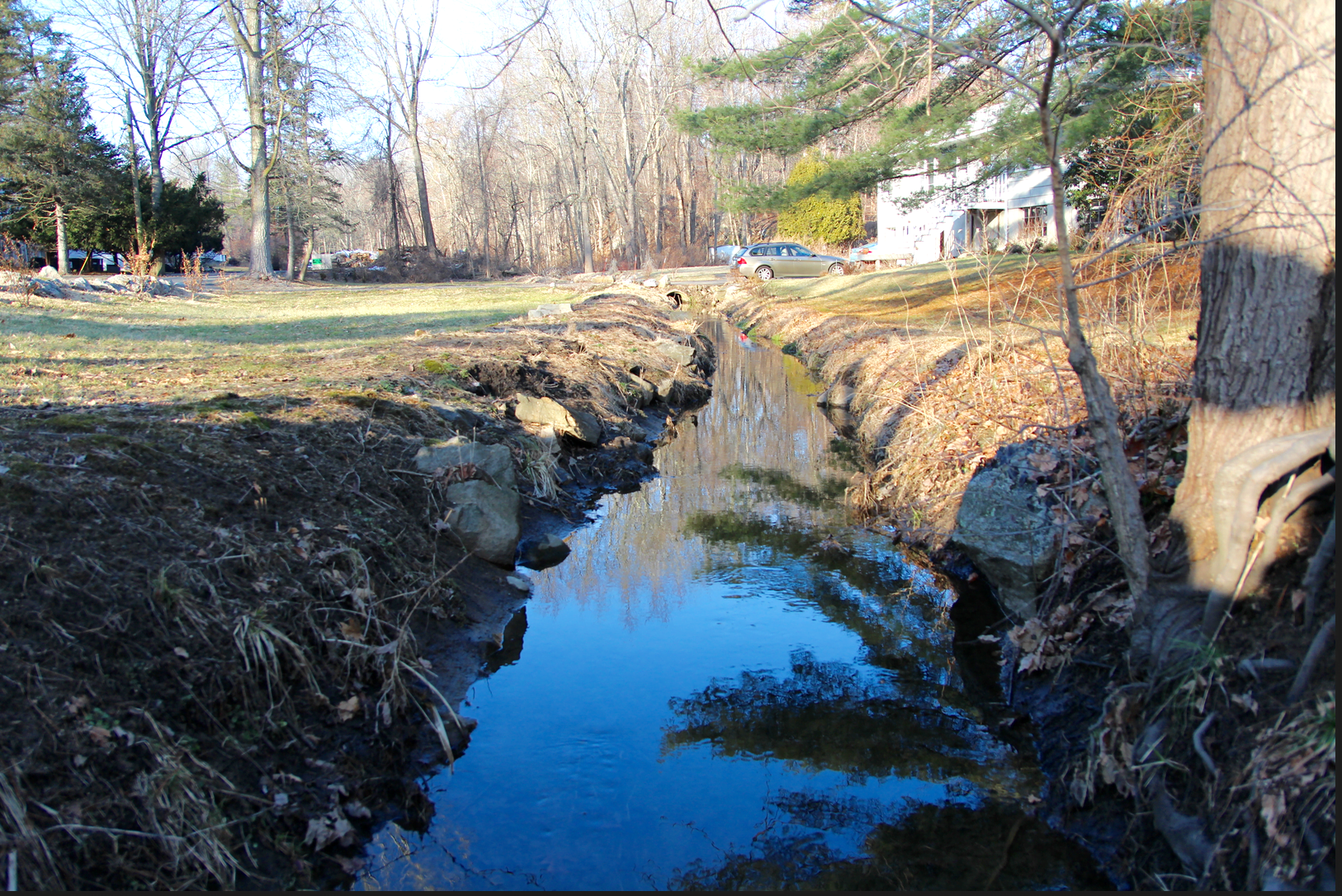
View from culvert upstream on Mr. Abaroa’s property at 4 Apple Tree Lane. Feb 14, 2018 Photo: Leslie Yager
Mr. Abaroa said a brook leading to the Palmer Hill Road culvert that drains 160 acres and passes through his front yard, is both undersized and a safety hazard. He asked the board to upgrade the culvert a higher priority in their recommendations to the BET for projects to be funded, and pointed out that Palmer Hill Rd is an arterial road leading to Stamford Hospital.
Mr. Abaroa, who bought his house for $750,000 in 2016 from the estate of Kelly Romaniello, said he and his fiancée plan to raise a family in the home, which is districted for nearby North Mianus School.
Abaroa said there is more water in the brook since development began of a six-lot subdivision in Hillcrest Park at 269 Palmer Hill Road, that was formerly “Buena Vista,” also known as “The Castle,” located up a steep grade behind his home. He showed the board photos of dirty brown water he attributed to the development.
Fletcher Development LLC’s website for the development, The Estates at Hillcrest, indicates two homes are sold, two are due to be completed this year, and two are pencil drawings.
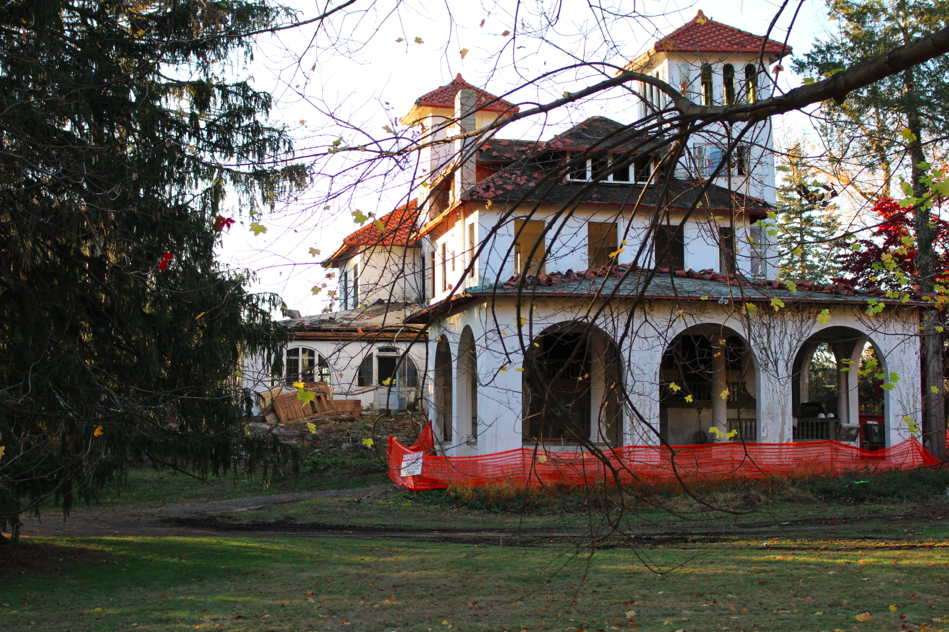
Before demolition “Buena Vista,” also called “The Castle,” in Hillcrest Park. November 2014 Photo: Leslie Yager

Houses under construction at 269 Palmer Hill Road. Feb 20, 2018
Abaroa said construction is resulting in an increase in impervious ground amounting to a size larger than a football field and that runoff from the property comes down the steep slope and into the brook that runs in front of his yard.
Back in 2015 when the the developers of the property, represented by engineer Tony D’Andrea and attorney Chip Haslun, initially went before the P&Z commission, director Katie DeLuca expressed concerns about the drainage and the detention basin, but in subsequent meetings, the application was approved.
On Thursday, when FECB members and DPW Deputy Commissioner Jim Michel, asked Mr. Abaroa whether he had seen water come up over Palmer Hill Road, he said he had not seen that, but was sure it had happened.
“I have,” said Elena Cantavero, a resident of Apple Tree Lane for 49 years.
“For years I have been personally involved in cleaning the culvert to keep it flowing,” Cantavero said. I’ve learned that recently Dan (Mr. Abaroa) fell while cleaning the culvert.”
Both Mrs. Cantavero and Abaroa said they regretted all the effort they had put into clearing the grate over the culvert, because not only is it dangerous to work from the steep slope, but that it has kept the town from having an awareness of the issue.
“I thought I was helping the town,” Cantavero said, adding that the grate is constantly clogged with leaves and litter.
Cantavero said flooding in recent years has been terrifying.
“Where are we going to go. What are we going to do?” she asked, adding that the addition of a grate placed over the box culvert may have created another problem. “It’s almost worse than before. Now the water is rising more than it ever did before.”
“I don’t know if it’s because of the new houses,” she said in reference to six lot subdivision where once was a single mansion. “They cut all the trees and it’s going to take a long time for them to grow. You build six houses on top of a mountain and you live below, you have a flooding issue. I wish I had more faith in the plans. It’s scary.”
Abaroa said he too was finished cleaning out the grate during heavy rains.
“We’ve done deep surgery on this culvert without actually upgrading it. I typically go out there in a storm and scrape the grate while it’s raining. This past weekend I slipped and fell and told myself I will not do it any more,” he said. “Now, I’m always going to call the Highway Department and police during storms and they’ll be the ones doing the scraping.”
Abaroa said the town spends $12,000 in annual upkeep including cleaning. The FECB has the project listed as costing $780,000.
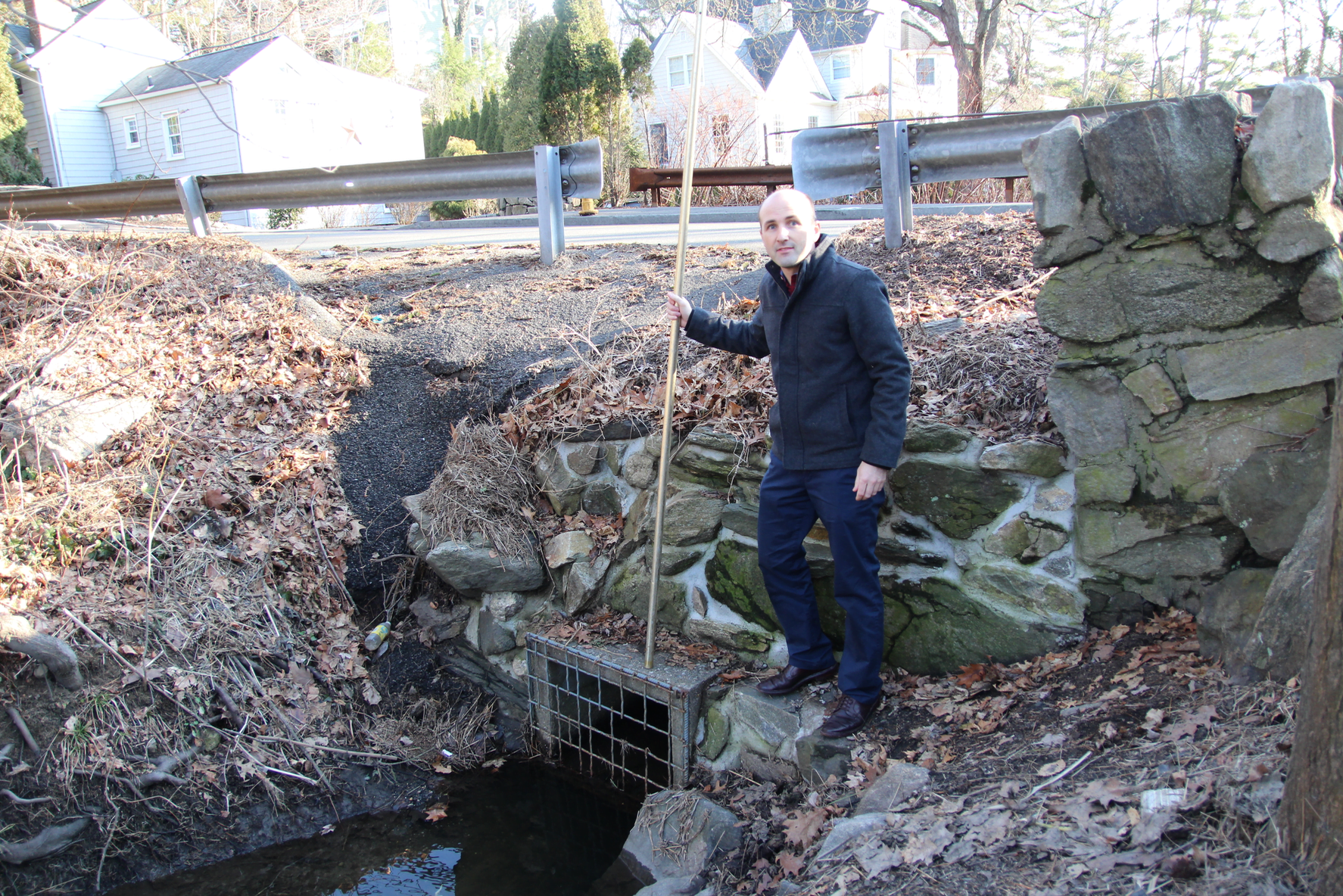
Daniel Abaroa stands on the steep incline by the Palmer Hill Rd culvert. Recent mortar repairs are visible. A grate was put over the culvert box in recent years. Feb 14, 2018 Photo: Leslie Yager
Mr. Abaroa elaborated on other reasons he felt the culvert upgrade should be a higher priority for the town. He said cars speed down the steep hill and through the intersection with Orchard and Apple Tree and could hydroplane if water were to cover Palmer Hill Rd.
He said the culvert is an attractive nuisance for children walking to school, and there is a bus stop across the street.
“This culvert has been inadequate for years and water has worked its way under the box culvert,” he said.
Abaroa said the culvert dates back to 1893 and was originally made of stone and mortar. He said when the road was widened, box culverts were added to each end. “It’s not a box culvert. It’s stone and mortar that was built into the shape of a pipe,” he said.
Abaroa said the town should not approve the remaining lots for development at 269 Palmer Hill Road until a downstream analysis is conducted.
The board replied that the culvert is “not unique” and that downstream analysis is not required.
The FECB also said the priority list of culverts for improvement is derived based on input from the town’s emergency responders, and that approval of the lots at 269 is not within the FECB’s purview, but rather that of Wetlands and Planning & Zoning.
The FECB said Mr. Abaroa had come up with his own criteria, which appeared to be based on his own observations.
Deputy DPW Commissioner Mr. Michel said emergency personnel had not informed the FECB of Palmer Hill Road ever going under water.
“You should familiarize yourself with our prioritization process,” said Aubrey Mead. And it troubles me that people have not seen Palmer Hill Road under water.”
“You’re not unique,” said Ed Schmeltz. “There are any number of locations that have the same problem. You’re not unique by any means.”
The board said the existing culvert made possible upstream storage of water and that if water in the brook flowed faster, it might have downstream impacts.
Mr. Michel said the project at 269 Palmer Hill Rd complies with the drainage manual, and that the 7 drainage manual requirements Mr. Abaroa argued had not been adhered to were ones generally applied “for much larger developments with a significantly larger impact.”

Recent photo, upstream of Palmer Hill Rd culvert on Apple Tree Lane. contributed
“We’ve looked at this project and it meets the drainage manual,” Mr. Michel said. We have offered Mr. Abaroa to come into the office and review the documentation and look at any information and he has refused.
“I reviewed it and the data does not exist,” Abaroa said.
“We can’t put it to the BET until it is in the top 10,” Mr. Mead said. “Our budget is minuscule.”
Mr. Mead said drainage systems are designed for 2 to 5 year storms. Jim Michel said maybe 10 year storms at the outside, though a few bridges are designed for 100 year storms.
“I’d be happy with a ten year storm,” Abaroa said. “Right now the culvert is only capable of meeting a 2-month storm.”

Abaroa driveway at 4 Apple Tree Lane after recent rain.
Abaroa said the firm CDM said did a study for the town and looked at the development and others in the area and said what was a 10-year storm standard would become a 2-year storm standard. He insisted the 269 Palmer Hill development does not comply with the drainage manual, but the board, and in particular Mr. Michel, said it does.
He said dirty water is coming down from the development in Hillcrest Park, and into the brook that runs past his front door. He said when he complained to DPW, he was told to go to Wetlands, which he did.
“The person who is going to have to dredge is me,” Abaroa said, adding that Wetlands senior analyst Bob Clausi visited his property.
He said Mr. Clausi wrote to him, “I stuck one of your fiberglass driveway marker poles into the bottom of the channel and found there is about 18″ to 24″ of sediment on top of the hard bottom, upstream of the culvert.”
FECB alternate Allison Walsh asked why a downstream analysis wasn’t required for the development at 269 Palmer Hill Rd.
Board member Peter J. Finkbeiner, P.E. said no, downstream analysis is not required.
“Whether you agree or disagree what you’re seeing here, shouldn’t we know whether it’s going to get worse? I think we should do that analysis,” Abaroa said, adding that residents have started a petition asking DPW to make the Palmer Hill culvert more of a priority. Elizabeth Peldunas, co-president of the Riverside Association, attended part of the meeting, which went from 2:00pm until about 5:00pm.
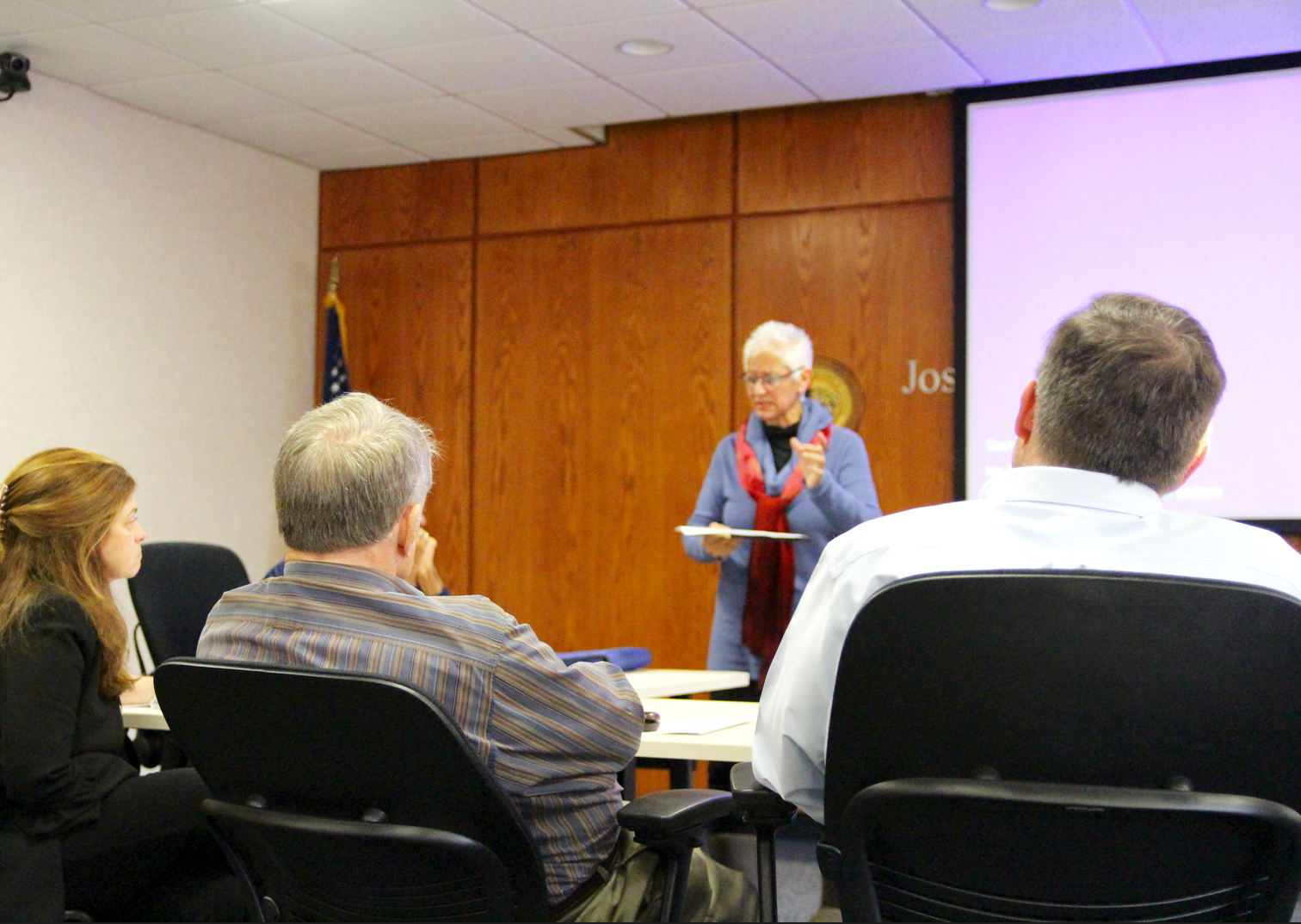
Elena Cantavero of Apple Tree Lane said flooding on her street has worsened over the years and asked for the Palmer Hill Road culvert be upgraded. Feb 15, 2018 Photo: Leslie Yager
Back on June 5, 2007 Gus Cantavero wrote a letter to Lloyd Hubbs at DPW, giving a history of Apple Tree Lane, the property his family bought in 1938 and built three houses on. He said that for decades there had been mild flooding during heavy rains, but that the flooding had become a very serious problem following construction of new homes on Hillcrest Lane. Mr. Cantavero, who died in 2015, said water had started coming down the hill “like a waterfall,” behind Mr. Abaroa’s home, which at the time was Mr. Cantavero’s uncle’s home. He wrote that the house had 5 feet of water in the basement, blowing out the electrical panel.
“These last two storms were the worst in our lives, we never experienced so much damage,” wrote Mr. Cantavero in 2007. “He said sump pumps were useless because water was gushing not from the floor but gushing through the cellar door, and that he had to replace a burner, hot water heater, freezer, refrigerator, lawn mower, leaf blower, among other items. “The water reached such high levels that it even seeped into our vehicles through the tops of the engines,” he wrote, adding that he wished the town would look into widening the culvert under Palmer Hill Rd.
Mr. Cantavero concluded his 2007 letter by asking “Why did the Town allow all those houses to be built above up and did not allow for proper storm water run off?”
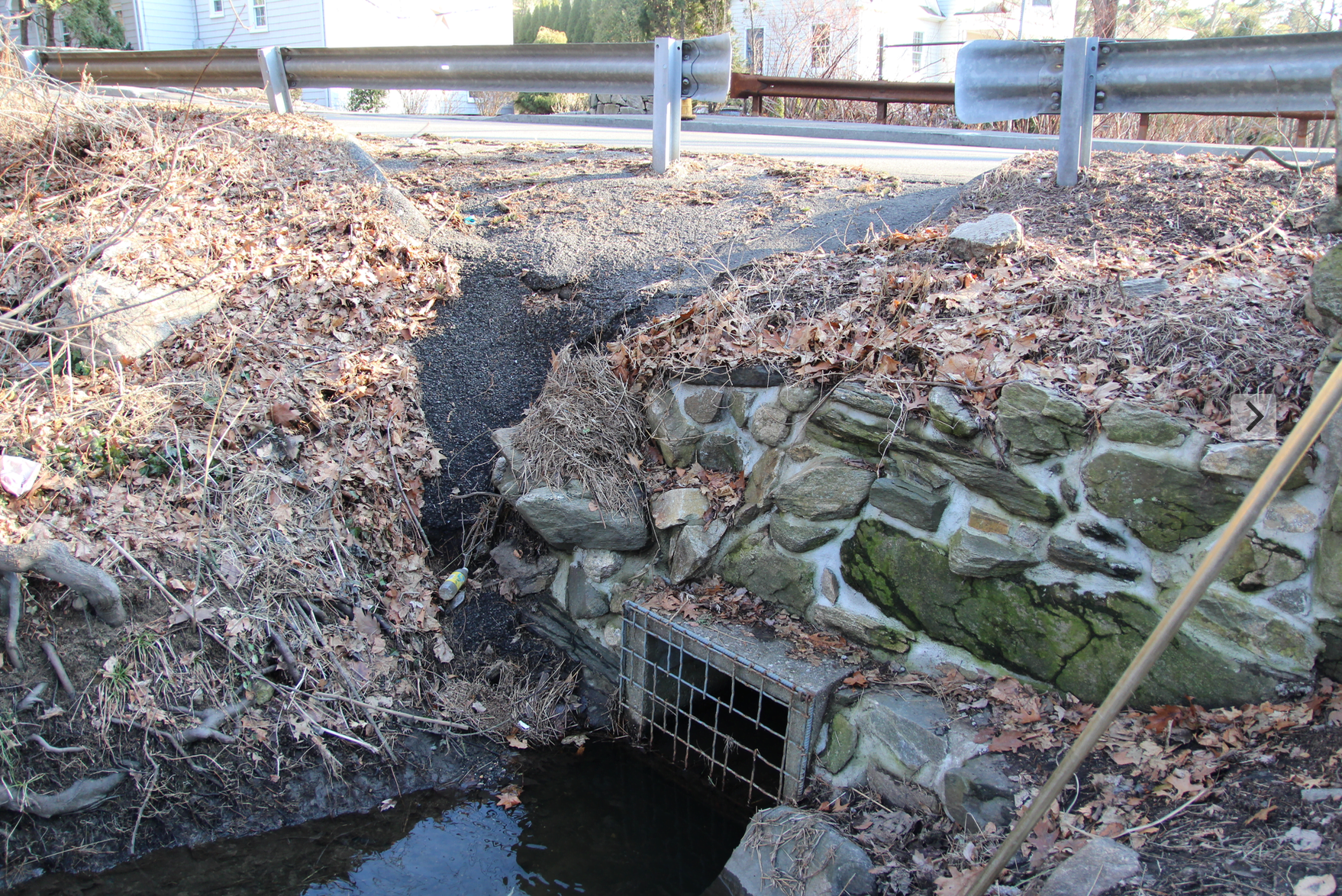
See also:
Where A Man’s Home Was a Castle, P&Z Says ‘Not So Fast’ on Palmer Hill Subdivision
PHOTOS: What’s Next for the Wrecking Ball in Greenwich? Buena Vista in Hillcrest Park